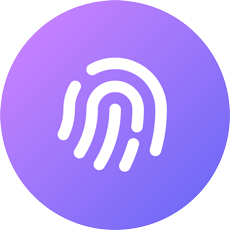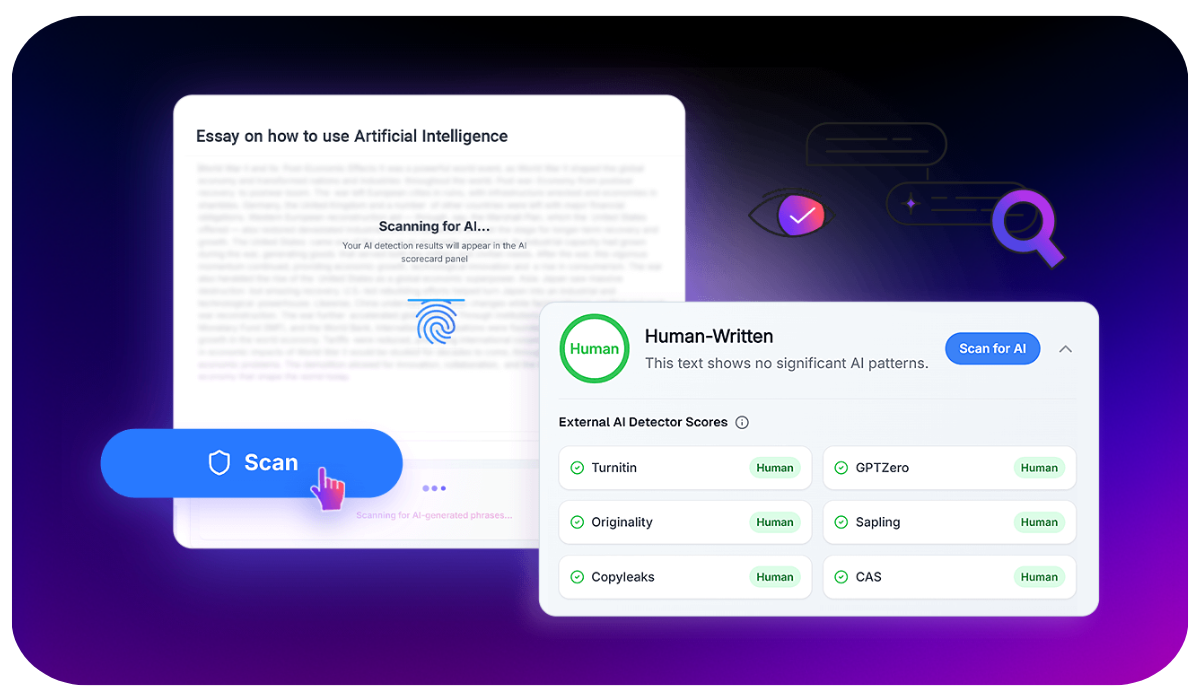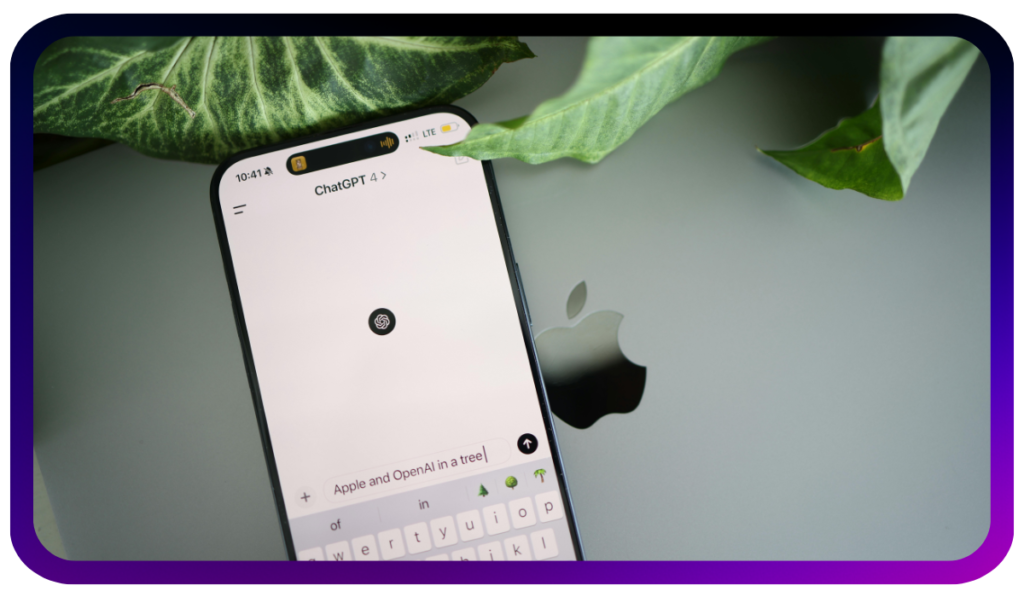AI detection scores try to calculate the possibility of a text being generated by AI. But they are yet to become perfect.
A high score never means a text is AI-written, and a low score doesn’t guarantee that it was actually written by a human.
These tools are built to spot patterns in how text is written—but they’re not perfect. False positives still happen more often than you’d expect.
This article breaks down how AI detection scores actually work, how much you can trust them, and what you can do to tweak your writing so it sounds more human without losing your voice or message.
What Is an AI Detection Score?
Understanding AI Scores & How They Are Measured
An AI detection score is essentially a prediction of whether a passage of writing was produced by a person or by AI. It’s often displayed as a percentage — the higher the number, the more likely the tool believes that AI wrote a piece.
Some tools for spotting AI Text include GPTZero, Turnitin, Walter Writes AI, and Originality. AI uses machine learning to discover this. They examine how sentences are built, how the ideas flow, what kinds of words one uses, and if the writing has a certain uniqueness to it. Next, they check your text against countless examples from both humans and AI to reach their best guess.
How AI Detection Scores Work in Different Tools Each tool has its own scoring method and thresholds:
- GPTZero evaluates perplexity and burstiness to detect predictable AI-like patterns.
- Turnitin flags high AI content above 20%, often combining this with plagiarism detection.
- Walter Writes AI and similar tools offer AI detectors along with humanizers that improve text authenticity.
- Originality.ai is tailored for content marketing, checking for AI use, and plagiarism.
These tools may produce different scores for the same content, so results should be interpreted with context.
What Does an AI Detection Score Mean?
The AI detection score is typically a number between 0–100, telling you how likely a text was generated by an AI. Obviously, a higher score means AI is more likely written it; a lower score means the author is possibly a human, the opposite.
But this score doesn’t tell you the exact percentage of AI-generated content.
For example, a “60% Original/Human” score doesn’t mean that 60% of the text is human-written and 40% is generated by AI. It means the AI detector is 60% confident the text was written by a human.
It’s still helpful, but the problem is that they are far from perfect.
AI Score Ranges & Their Interpretation
| 0–20% | Likely human-written |
| 21–50% | Mixed signals – may contain edited AI or very structured human text |
| 51–80% | Likely AI-generated with minimal human edits |
| 81–100% | Strongly AI-generated |
Common Misconceptions About AI Detection Scores
- AI detection tools are not 100% accurate – they can misclassify human content as AI.
- Editing AI-generated text lowers the score, but it doesn’t mean it’s entirely original.
- AI detection is not the same as plagiarism – using AI does not always equal unethical behavior.
How Much AI Content Is Acceptable?
Academic Standards for AI Detection in Universities
- Most universities only permit a small amount of AI-generated content—typically between 0% and 15% in student submissions.
- Fully AI-written essays are usually not allowed and can lead to academic consequences.
- More and more institutions are now including AI detection as part of their standard plagiarism checks, adding another layer to academic integrity policies.
AI Usage in Professional Writing & Publishing
- In journalism and publishing, AI-assisted content is often accepted, but only if it’s carefully reviewed and fact-checked by a human before it goes live.
- When it comes to SEO, Google doesn’t penalize content just because it’s written by AI as long as it’s genuinely helpful and adds real value for readers.
How to Lower an AI Detection Score Without Losing Quality
Best Practices for Humanizing AI-Generated Text
- Try rewording your sentences using fresh, natural phrasing rather than just swapping out synonyms.
- Add personal touches or specific details that only a human would include—this helps your writing feel more unique.
- Avoid overly simple sentence constructions. Instead, try weaving in idioms, metaphors, or a more conversational tone to bring your writing to life.
Editing Strategies That Reduce AI Flags in Detection Tools
- Mix up the rhythm of your writing—use a mix of short, punchy sentences and longer, more detailed ones to keep things interesting. Don’t worry too much about sticking to just active or passive voice—use whatever fits best at the moment.
- Instead of saying the same thing over and over, focus on guiding the reader naturally from one idea to the next. Transitions and variety in your wording can really help your writing flow.
- Above all, let your voice come through. Don’t overload your content with keywords or stuff in awkward phrases just to meet some rule—if it doesn’t sound like something you’d actually say, it probably needs a tweak.
How Tools Like Walter Writes AI Help Improve AI-Generated Content
- The “Humanize and Scan” feature is designed to make your AI-generated writing sound more natural while lowering the chance of detection.
- It improves how your content reads by introducing variety, smoothing out awkward phrases, and keeping your original ideas front and center.
- With Walter Writes AI, your writing still sounds like you—just polished, more engaging, and ready to pass both the human and machine tests.
How Is the AI Detection Score Calculated?
AI detection scores are generated by algorithms that look at the way your text is written. They analyze things like sentence structure, word choice, coherence, originality, and overall complexity to figure out how likely it is that the content was created by an AI.
Originality plays a big role here. If your writing sounds fresh and unique—not repetitive or overly generic—it’s more likely to be seen as human-written. For example, content that lacks coherence or feels overly formulaic tends to trigger higher AI detection scores.
AI detection scores are measured using algorithms that consider several linguistic and structural patterns of a text.
They analyze various features, which include originality, coherence, complexity, and word choice, to determine the probability that the text was produced by AI.
Originality: Text that looks fresh and free from excessive redundancy generally receives higher marks for being human-written.
Coherence: Lower AI detection score with a logical flow of ideas, smooth transitions, and well-structured sentences.
Complexity: Using different sentence structures, idiomatic phrases, and variety in terminology can help you create content that sounds more ‘human.
AI detectors inspect the given text by analyzing and comparing it with very large data sets of human and AI-written content (looking for patterns that tend to be associated with AI).
But the concern is that these tools are not 100% reliable and can sometimes flag human-written content as AI. So it’s a problem.
Are AI Detectors Accurate With Their Scoring?
AI detection tools are imperfect, and they frequently misidentify human-authored content as AI-written. These tools are based on algorithms trained on AI-generated text patterns, but their datasets have baked-in limitations that make them prone to false positives.
For example, historical documents such as the U.S. Constitution, written in 1789, have been identified as AI-written, even though they were produced long before any AI tool existed. Other studies have shown that some AIdetectors even misclassify a decent percentage of human-written content as being written by an AI.
Different AI detectors can also yield conflicting results for the same text. This explains why we shouldn’t treat AI scores as God’s judgment but rather as a guideline.
AI detection tools may help identify some machine-generated content, but you can’t rely on them as the only way to conclude authenticity. Instead, the only way to evaluate content effectively is through manual review and contextual awareness.
What to Do If Your AI Score Is High?
A high AI detection score means your text is likely flagged as AI-generated. But don’t worry—there’s a way to fix it.
Why does this happen?
Even when using carefully crafted ChatGPT prompts, AI-generated content often follows predictable patterns.
The phrasing, sentence structure, and repetition can trigger AI detectors, making your content seem artificial—even if you’ve refined it multiple times.
For example, let’s generate a paragraph using ChatGPT:
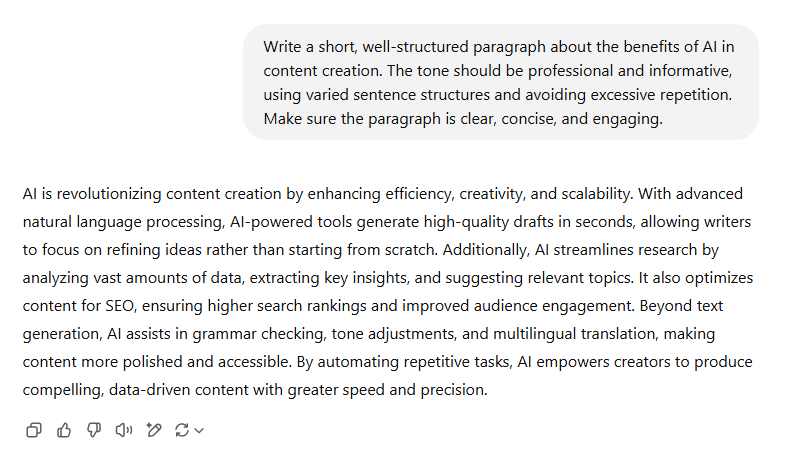
Now, let’s check its AI detection score using Walter Writes AI Detector:
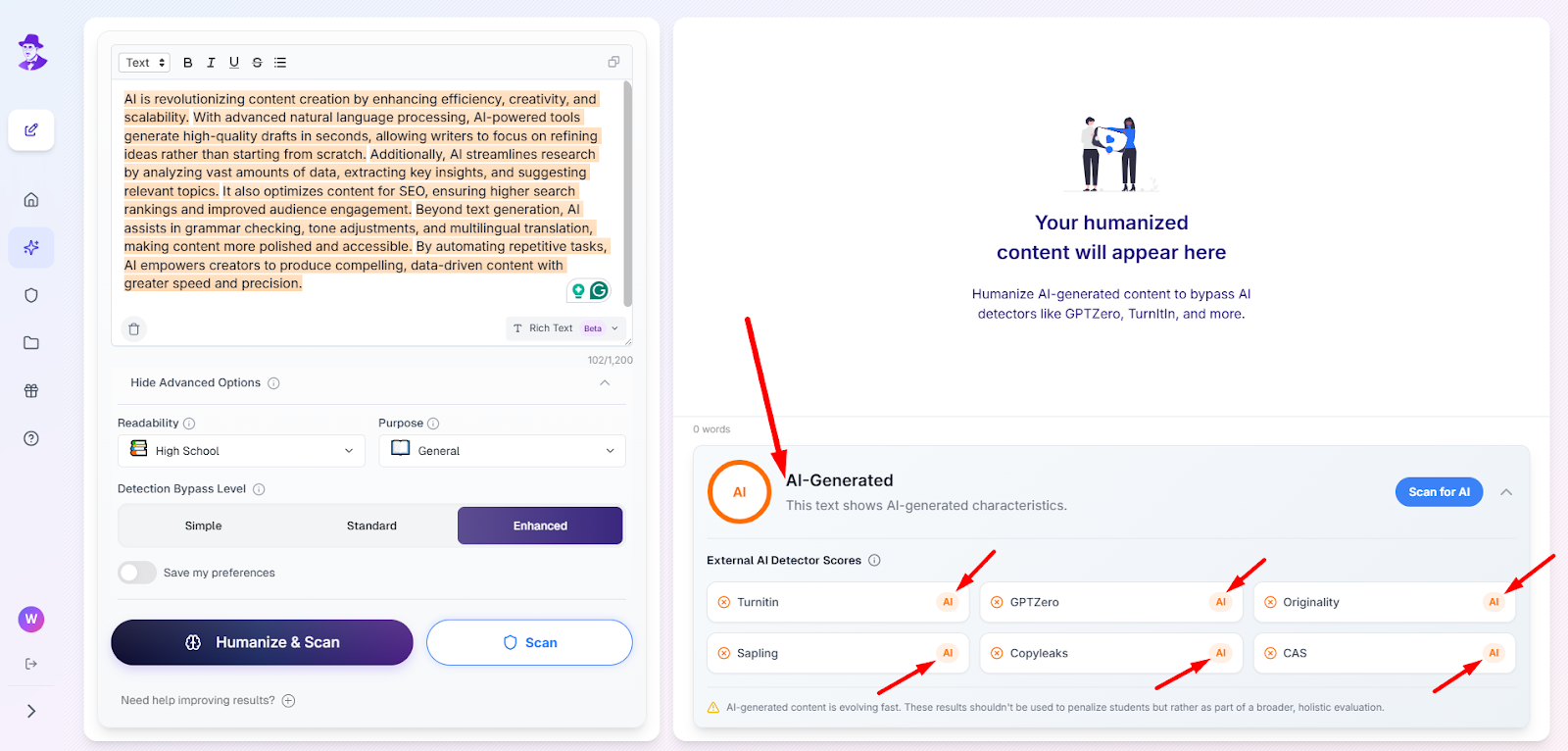
Despite tweaking the prompt, the score still indicates AI-like writing patterns.
So, How Do You Lower Your AI Score?
This is where an AI humanizer tool comes in.
Let’s take the same AI-generated text and run it through Walter Writes AI Humanizer:
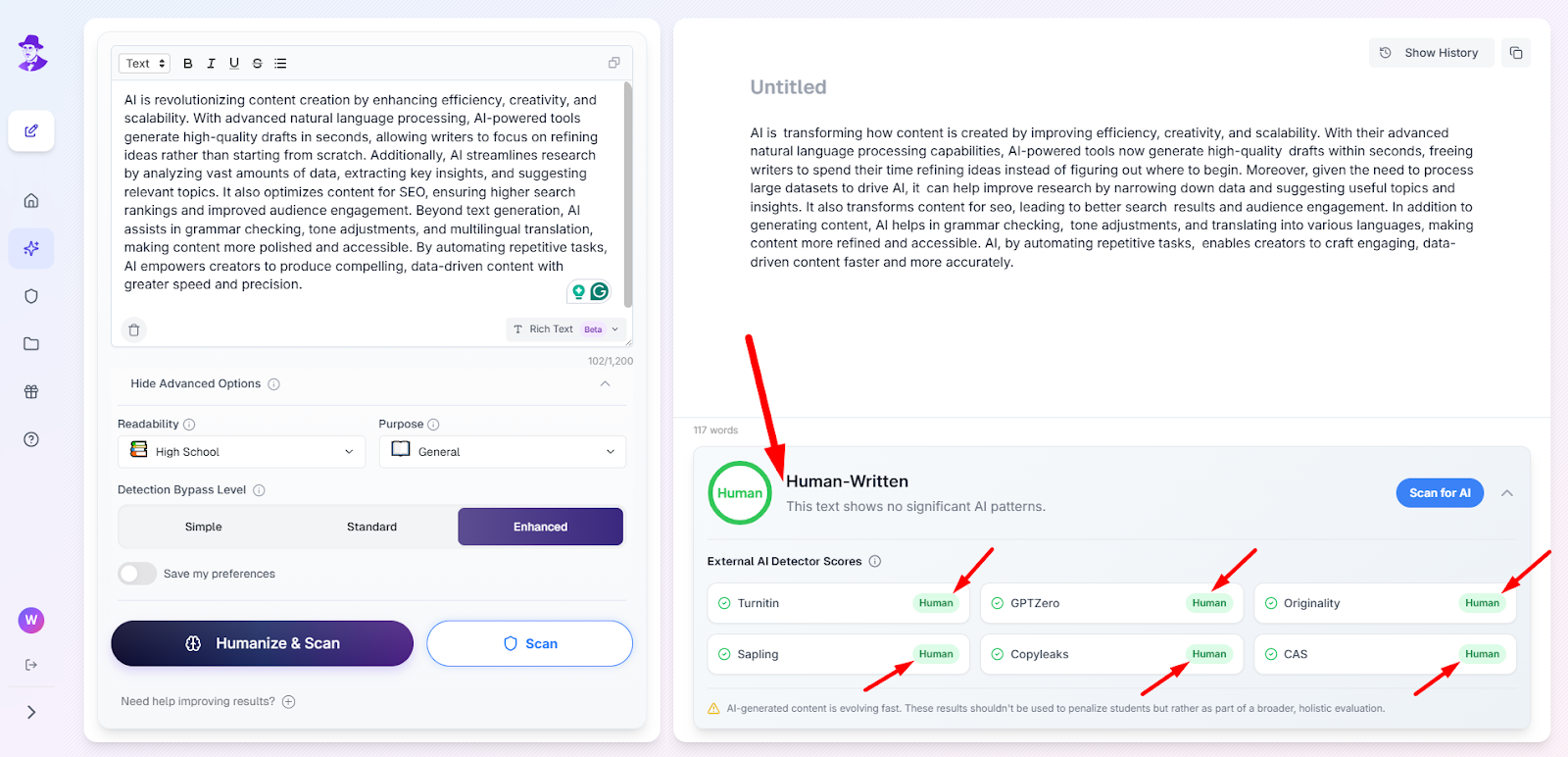
With just one click on the “Humanize and Scan” button, Walter Writes AI rewrites the text to sound naturally human—ready to pass AI detection and resonate with real readers.
If your AI score is high, don’t waste time rewriting it manually. Just use Walter AI Humanizer and get instant, authentic results.
What is an Acceptable/Good AI Score?
An acceptable score on an AI detection test depends on the tool used.
As Turnitin, scores below 20% are usually safe, as false-positive matches can contribute to lower scores. More than 20% indicates a greater chance that AI was involved.
As for GPTZero, the utility has an 80% accuracy rate and a 0.90 specificity, meaning that it is better at identifying human-written content but is still capable of misclassifying some text.
In general, lower AI scores are good, but no detection tool is infallible, so always be sure to review manually.
What Is a False Positive?
A false positive is when an AI detection tool wrongly classifies human-written content as written by AI. This makes it problematic, particularly in academic and professional environments, wherein we may be falsely accused of plagiarism or misconduct.
False positives sometimes result from writing patterns similar to those in AI-generated text, like structured sentences, repetitive phrasing, or overly formal language. As AI detectors are imperfect, trusting their output alone should be approached with caution.
Frequently Asked Questions (FAQ)
An AI score represents the likelihood of text being AI-generated based on linguistic patterns.
Most allow 0-15% AI-generated content, but policies vary.
Rewrite AI-generated text, add original ideas, and use humanizer tools like Walter Writes AI to refine content.
No, false positives and negatives are common, especially with human-edited AI text.
No, AI-generated content isn’t necessarily plagiarized, but it can be flagged under academic policies.
Conclusion: Are AI Detection Scores Accurate?
AI detection scores are designed to estimate the chances that a piece of content was written by artificial intelligence. But here’s the thing—they’re not 100% accurate.
A high score doesn’t automatically mean your writing was generated by AI, and a low score doesn’t guarantee a human wrote it. There’s still a lot of gray area.
These detectors work by analyzing linguistic patterns—things like sentence structure, word choice, and flow. But they’re not perfect.
In fact, they often produce false positives, flagging content that was actually written by a real person. That’s why relying solely on the score can be misleading. A human review is still one of the most reliable ways to judge content authenticity.
If you do get a high AI score, don’t panic. There are tools out there, like AI humanizers, that can help make your writing sound more natural and less machine-like.
Small adjustments to your tone, sentence variety, and word complexity can go a long way in making your content feel more genuine—and less likely to be flagged.
Use Walter Writes AI to humanize AI-generated text and ensure originality!
